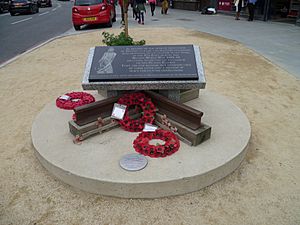Burma Railway Memorial facts for kids
The Burma Railway Memorial is a special monument in London, near Mornington Crescent tube station. It remembers the many thousands of British soldiers and regular people who were captured during the Second World War. These brave individuals became prisoners of war and suffered greatly. They were forced to build the difficult Burma Railway and many died from sickness, hunger, or harsh treatment. This memorial helps us remember their sacrifice.
Contents
What is the Burma Railway Memorial?
This memorial was created to honor the people who suffered while building the Burma Railway. It stands as a reminder of a very tough time in history. The memorial is located on Camden High Street in London.
The Story of the Burma Railway
During the Second World War (from 1939 to 1945), many countries were fighting. In Asia, Japanese forces captured many soldiers and civilians from Britain and other Allied nations. These prisoners were forced to build a railway line, often called the "Death Railway." This railway stretched about 415 kilometers (258 miles) between Thailand and Myanmar (which was then called Burma).
The conditions were terrible. Prisoners worked long hours in the hot jungle, with little food or medicine. They faced dangerous diseases like cholera and malaria. Many thousands of them died while building the railway. It was a very sad and difficult time for these prisoners of war.
How the Memorial Looks
The Burma Railway Memorial was designed by an architect named Chris Roche. People in the local newspaper, the Camden New Journal, helped campaign for it. The memorial has a large stone slab made of granite. This slab rests on short pieces of wooden railway sleepers and metal rails, just like real railway tracks. It all sits on a round, white base.
On the granite slab, there is an important message written. There is also a drawing of a very thin prisoner of war. This drawing was made by an artist named Ronald Searle. He was also a prisoner and was forced to work on the Burma Railway himself. His drawing helps us understand how much the prisoners suffered.
Unveiling the Memorial
The memorial was officially shown to the public on September 21, 2012. A special person named John Slim, 2nd Viscount Slim helped unveil it. His father, Field Marshal William Slim, 1st Viscount Slim, was a very important military leader during the Second World War. He led the 14th Army in the Burma Campaign, which was the fighting in Burma. Having his son unveil the memorial made the event even more meaningful, connecting it to the history of the war.


